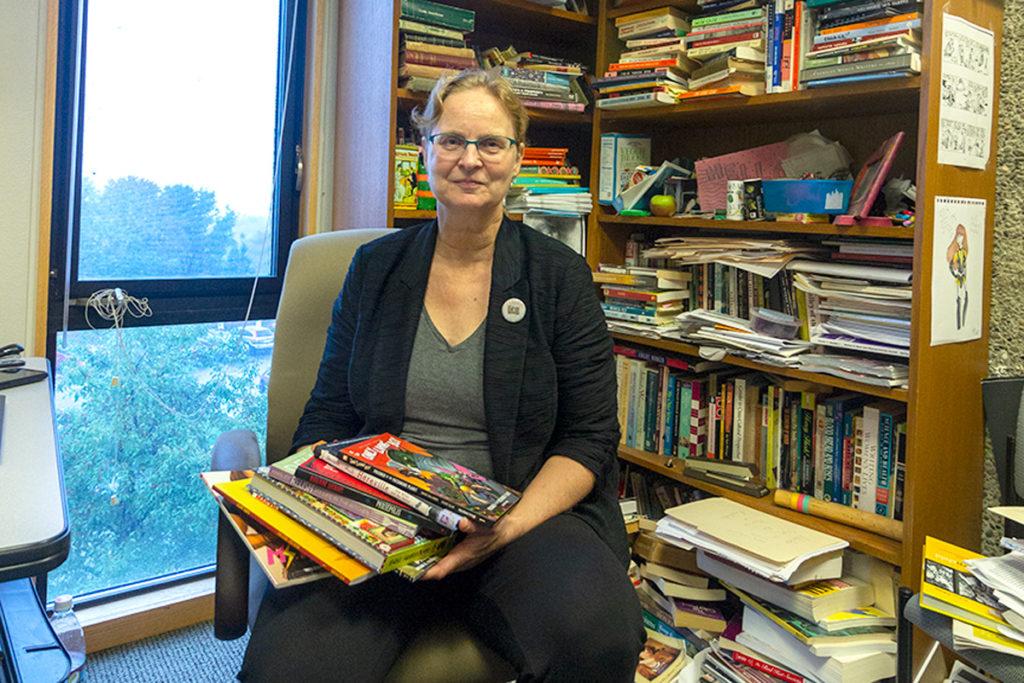Four Ithaca College students make up the Graphic Novel Advisory Board: a new one-credit class dedicated to assisting rural libraries with their graphic novel selections for young readers.
The board is made up of junior Andrea Yzaguirre, senior Alexandria Paul and sophomores Angelina Randazzo and Ian Emmanuel. On top of reading, reviewing and discussing different graphic novels weekly, the group also uses their knowledge to recommend graphic novels to rural librarians so those librarians can make better selections for their readers.
The group was originally founded as a volunteer opportunity for students, organized by Katharine Kittredge, professor in the Department of English, in Spring 2018. The group is now a one-credit course offered at the college, which became official just a few weeks before the Fall 2018 semester, Kittredge said.
Kittredge said she wanted to find a way to help rural libraries select material that was beneficial for young readers. Around this time, she was assisting the college’s comic book club with their annual event, Ithacon. Through Ithacon, Kittredge was exposed to several graphic novel publications and learned how these publications with engaging visuals can benefit children and their reading, she said.
“Graphic novels are great for reluctant young readers,” Kittredge said. “It helps them get into the habit of reading and become more literate.”
Emmanuel, who is the newest member of the advisory board, said he hated reading as a child. Graphic novels were attractive to him because they included pictures, and this style helped him get more comfortable with reading, Emmanuel said.
“I wasn’t ever the best at reading or writing,” Emmanuel said. “I felt safe and comfortable reading graphic novels.”
Randazzo said graphic novels can help children build visual and textual literacy by associating the words they read with the pictures that accompany them. Graphic novels can also inspire disengaged students to be less discouraged by the idea of reading a book, Randazzo said.
Kittredge asked students in her classes if they would be interested in helping her with the idea, and after getting three students on board, GNAB was officially formed, Kittredge said. She said the group became active last spring with their first library visit to Lisle Free Library where she works. They have since completed one other site visit to the Newark Valley Library and are currently planning where they can visit next, Kittredge said.
During these site visits, the advisory board meets with rural librarians to discuss their graphic novel selections. Randazzo said the librarians give the advisory board an idea of what kind of material they want to be covered in the novels, what kind of children are reading the novels and what the budget is for the total order.
The advisory board then uses the information they receive from the librarian and match it with graphic novels that best suit the library’s needs. Paul said this is the most rewarding part of being on the advisory board.
“I love meeting different librarians and finding out how we can help,” Paul said.
To organize the different graphic novels they read, the students of the advisory board have developed a spreadsheet where they post information about each novel, Randazzo said. This makes it easy to reflect on the content of different novels and better recommend material for different libraries.
For each book, the students record the title, authors, illustrators, target demographic, genre and subjective rating by each member who read it, Paul said. They also include the ISBN-13, or standard book number, for each novel, so the librarians can order them easily. While a lot of this work occurs outside of classroom time, the group also utilizes the class to talk about what graphic novels they’ve been reading, Randazzo said.
In the future, the advisory board wants to expand its group with more members and more libraries, Paul said. Emmanuel, who is the newest member of the board, is currently constructing a website so the work of the advisory board can be made public. With an online presence, more libraries and schools will be able to use the board’s research as a source for information on graphic novels, Paul said. Emmanuel said when the website goes live, the advisory board will post blogs, reviews of graphic novels and information on the positive effects graphic novels have on young readers. By doing this, the board will be able to serve as a resource for libraries and individuals everywhere, not just places within driving distance, Kittredge said.
For now, the advisory board is focused on helping one library at a time but hope to one day be able to assist multiple libraries at once, Randazzo said.
“We want to become a resource for libraries,” Randazzo said. “We want to help them expand their graphic novel collections, so the kids reading them can receive the benefits.”








